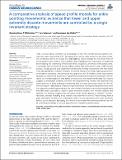A Comparative Analysis of Speed Profile Models for Ankle Pointing Movements: Evidence that Lower and Upper Extremity Discrete Movements are Controlled by a Single Invariant Strategy
Author(s)
Vaisman, Lev; Krebs, Hermano Igo; Michmizos, Konstantinos
DownloadMichmizos-2014-A comparative analys.pdf (2.281Mb)
PUBLISHER_CC
Publisher with Creative Commons License
Creative Commons Attribution
Terms of use
Metadata
Show full item recordAbstract
Little is known about whether our knowledge of how the central nervous system controls the upper extremities (UE), can generalize, and to what extent to the lower limbs. Our continuous efforts to design the ideal adaptive robotic therapy for the lower limbs of stroke patients and children with cerebral palsy highlighted the importance of analyzing and modeling the kinematics of the lower limbs, in general, and those of the ankle joints, in particular. We recruited 15 young healthy adults that performed in total 1,386 visually evoked, visually guided, and target-directed discrete pointing movements with their ankle in dorsal–plantar and inversion–eversion directions. Using a non-linear, least-squares error-minimization procedure, we estimated the parameters for 19 models, which were initially designed to capture the dynamics of upper limb movements of various complexity. We validated our models based on their ability to reconstruct the experimental data. Our results suggest a remarkable similarity between the top-performing models that described the speed profiles of ankle pointing movements and the ones previously found for the UE both during arm reaching and wrist pointing movements. Among the top performers were the support-bounded lognormal and the beta models that have a neurophysiological basis and have been successfully used in upper extremity studies with normal subjects and patients. Our findings suggest that the same model can be applied to different “human” hardware, perhaps revealing a key invariant in human motor control. These findings have a great potential to enhance our rehabilitation efforts in any population with lower extremity deficits by, for example, assessing the level of motor impairment and improvement as well as informing the design of control algorithms for therapeutic ankle robots.
Date issued
2014-11Department
Martinos Imaging Center (McGovern Institute for Brain Research at MIT); Massachusetts Institute of Technology. Department of Mechanical Engineering; McGovern Institute for Brain Research at MITJournal
Frontiers in Human Neuroscience
Publisher
Frontiers Research Foundation
Citation
Michmizos, Konstantinos P., Lev Vaisman, and Hermano Igo Krebs. “A Comparative Analysis of Speed Profile Models for Ankle Pointing Movements: Evidence That Lower and Upper Extremity Discrete Movements Are Controlled by a Single Invariant Strategy.” Frontiers in Human Neuroscience 8 (November 27, 2014).
Version: Final published version
ISSN
1662-5161